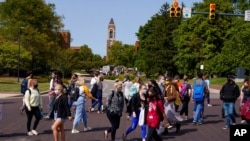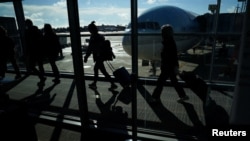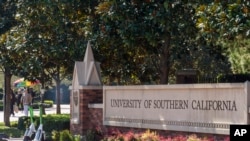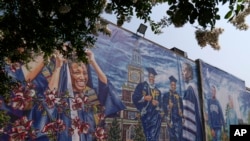Student Union
New International Student Enrollment Falls 43% in the US

COVID-19 has drastically cut international student participation in U.S. colleges and universities, punctuating three years of declining enrollment tied to costs, immigration barriers and perceived chaos in American society.
In the school year that began three months ago, new enrollment of international students dropped 43% because of COVID-19. Nearly 40,000 students — mostly incoming freshmen — have deferred enrollment at 90% of U.S. institutions to a future term.
The data were compiled and reported by the Institute for International Education and published in its annual Open Doors report about international students in the U.S. It is funded by the U.S. Department of State, which issues visas to students and visitors participating in educational or vocational training.
“The COVID-19 pandemic has impacted international student enrollment,” IIE report stated. “Many international students studying at U.S. institutions took advantage of opportunities to begin their studies remotely.”
Of the more than 1 million enrolled international students in the U.S., 20% turned to online learning this semester because of COVID-19 campus shutdowns. While some international students returned to their home countries, others are living off-campus or under strict guidelines on campus.
COVID-19 emerged on the cusp of 2020, while most university students were on winter break for Christmas and New Year’s. Students returned from points around the globe to their U.S. campuses, but by spring break in March, COVID-19 had become a pandemic and schools were struggling with how to keep their populations safe. Most campuses sent students home, shut down and moved instruction online.
Students and families pushed back on paying the high cost of tuition and fees, which can reach $70,000 per year for an undergraduate degree in the U.S., and 56% of international students pay out of pocket for their U.S. education. Many requested refunds and discounts for lack of dining and housing facilities, where universities derive the bulk of their student revenue.
The most recent data about enrollment in the semester that started this fall comes from IIE’s “fall snapshot,” which gathers data from more than 700 schools and is conducted by IIE and nine partner associations of higher education. The Open Doors data for the previous school year from August/September 2019 to May 2020 looks at a larger sample of 2,900 institutions.
There were 1,075,496 international students in the U.S., down nearly 2% from the previous year of 1,095,299. China and India again comprised more than half of the total. China sent 372,532 students to study in the U.S. while India sent 193,124.
While Chinese students increased at American schools by 0.8%, India sent 4.4% fewer students to the U.S. from year before.
At graduate schools, Chinese student numbers increased 3%. Those pursuing Optional Practical Training (OPT) increased 2%. OPT allows students to work in their field of study, typically science, technology, engineering and math (STEM). More than half of all international students pursued STEM degrees.
Among the top 25 countries to send students to the U.S., 18 showed declines from last year. After China and India, students came to the U.S. from South Korea (-4.7%), Saudi Arabia (-16.5%), Canada (-0.5%), Vietnam (-2.5%), Taiwan (1.5%), Japan (-3%), Brazil (3.8%), Mexico (-5.8%), Nigeria (2.5%), Nepal (-3.8%), Iran (-5.7%), United Kingdom (-3.5%), Turkey (-6.7%), Germany (0.6%), Bangladesh (7.1%), France (-2.8%), Kuwait (-8.9%), Indonesia (-0.7%), Spain (9.5%), Pakistan (-0.2%), Colombia (-3.4%), Malaysia (-10.4%), Venezuela (-11.7%.)
International students comprise 5.5% of the 19,720,000 students enrolled in U.S. higher education.
In last year’s Open Door report, institutions indicated some of the reasons for the decline in enrollment, including the high cost of tuition at U.S. colleges and universities, difficulty in getting visas or the insecurity of maintaining a student visa throughout a student's education, students feeling a lack of welcome in the U.S., negative political rhetoric and news of crime in the U.S.
This year, NAFSA: Association of International Educators found that the 2019-2020 international enrollment declines cost U.S. colleges and universities $1.8 billion, or 4.4% less than the previous year ($38.7 billion).
It was the first time that the dollar amount international students contribute to U.S. colleges and universities dropped in 20 years, said NAFSA.
“As the economic value decreases, we are reminded of the immense contributions that international students bring to America. We cannot afford to lose these talented individuals to a competitor country,” said NAFSA Executive Director and CEO Esther D. Brimmer.
“Our policymakers and legislative leaders must reaffirm America’s commitment to international students and scholars because our universities and colleges have never stopped doing so, and neither have our competitor countries,” she added.
Top hosting states showed declines in the number of students, (total number of students and percentage change): California (160,592, -0.7%), New York (126,911, 2.1%), Texas (77,097, -5.9%), Massachusetts (73,695, 3.7%), Illinois (51,966, -3.3%), Pennsylvania (50,070, -3.4%), Florida (46,221, 0.6%), Ohio (35,508, -4.8%), Michigan (31,408, -5.5%) and Indiana (28,136, -3.3%).
While Northeastern University in Boston moved up and University of Southern California moved down one rank this year, the top universities otherwise remained New York University (21,093), Northeastern University in Boston (17,491), University of Southern California (17,309), Columbia University (17,145), University of Illinois-Urbana-Champaign (13,962), Arizona State University (13,136), University of California-Los Angeles (11,447), University of California-San Diego (11,272), Purdue University in Indiana (11,173), Boston University (11,158), University of California-Berkeley (10,695), Pennsylvania State University (9,244), University of Washington (9,236), University of Michigan (9,000), University of Texas (8,787), University of California-Irvine (8,773), Carnegie Mellon University in Pittsburgh (8,694), University of California-Davis (7,919), Ohio State University (7,894), and Cornell University in New York (7,623).
See all News Updates of the Day
Malaysian official: Schools can’t turn away from global tensions

Zambry Abdul Kadir, Malaysia’s higher education minister, said protests spreading across universities in the United States show that schools can’t ignore political tensions.
Helen Packer, reporting in Times Higher Education, said the minister reminded educators that universities are key in the development of leaders, individuals and societies. (April 2024)
Social media breaks are difficult, but necessary

Between online classes, maintaining social connections and working on projects, college students can have a hard time disengaging from the demands of technology.
In Florida International University’s PantherNOW, Ariana Rodriguez offers strategies for taking a break from social media. (April 2024)
- By Melos Ambaye
Many master's degrees aren't worth the investment, research shows

Nearly half of master's degrees have a negative financial return, according to new research by the Foundation for Research on Equal Opportunity, an economic research organization.
The study indicates that many graduate degree programs do not increase lifetime earnings enough to be worth it.
While 23% of bachelor’s degree programs yield a negative financial return on investment, 43% of two-year degrees and master’s degrees fail to deliver a return, according to the study by Preston Cooper, a senior fellow at FREOPP.
Cooper assessed the return on investment for 53,000 degree and certificate programs to determine whether a student’s lifetime earnings outweigh program costs and the risk of not completing their degree.
His findings show that a student’s field of study was the overriding indicator of return on investment at the undergraduate and graduate level.
Engineering, computer science and nursing bachelor’s degrees have high financial returns on investment, while programs in education, fine arts, psychology and English usually have low returns.
Graduate degrees in medicine and law tend to have strong payoffs. But a large share of master’s programs, including the MBA, frequently have low payoffs, according to Cooper.
Although workers with master’s degrees earn 16% more than those with only bachelor’s degrees, Cooper says the figure fails to account for students who had “higher preexisting earnings potential.”
“MBA students typically have high preexisting earnings potential, having often chosen high-ROI undergraduate majors such as finance and economics,” Cooper writes. “So the MBA adds little value on top of that.”
The study indicates that high starting salaries are predictors of high returns on investment. Degrees with starting salaries of $57,000 a year or more deliver the best lifetime returns.
But the return on investment of a degree can vary depending on the educational institution.
“Students interested in fields with low average pay can still find some schools that do well transforming those fields of study into high-paying careers,” Cooper writes.
The quality of an institution also matters, said William Tierney, professor emeritus of higher education at the University of Southern California.
“An MBA from Harvard is a likely ticket to a good job,” Tierney told VOA. “An MBA from the University of Phoenix, less so.”
But students pursue graduate programs for more than just financial reasons.
“Some degrees open up careers in fields that students may enjoy, such as in the performing arts,” Robert Kelchen, head of educational leadership at the University of Tennessee, Knoxville, told VOA.
“Others can help gain access to social networks or simply help students learn about a topic that is of interest,” Kelchen added.
Cooper told VOA that it might make sense for students in degree programs with low returns on investment to switch majors if they can still graduate on time.
He found the worst outcome for a student’s return on investment is dropping out of college “because they must pay for one or more years’ tuition and spend time out of the labor force.”
Lawmakers who fund higher education have a responsibility in ensuring “higher education delivers on its promise of economic mobility,” Cooper said.
Nearly a third of federal funding, including Pell grants and student loans, pays for higher education programs that fail to provide students with a return on investment, according to the study.
Cooper’s view is that “some schools should shut down low-ROI programs and reallocate institutional resources to programs with a better return.”
“There's definitely this narrative out there that higher education is always worth it, and you should always try to get that extra degree because it will increase your earnings,” he told VOA. “That's reinforced by colleges who make lofty promises regarding their graduate degree programs' outcomes, which all too often fall short.”
Harvard students end protest as school agrees to discuss Gaza conflict

Protesters against the war between Israel and Hamas were voluntarily taking down their tents in Harvard Yard on Tuesday after university officials agreed to discuss their questions about the endowment, bringing a peaceful end to the kinds of demonstrations that were broken up by police on other campuses.
The student protest group Harvard Out of Occupied Palestine said in a statement that the encampment "outlasted its utility with respect to our demands." Meanwhile, Harvard University interim President Alan Garber agreed to pursue a meeting between protesters and university officials regarding the students' questions.
Students at many college campuses this spring set up similar encampments, calling for their schools to cut ties with Israel and businesses that support it.
The Israel-Hamas war began when Hamas and other militants stormed into southern Israel on October 7, killing some 1,200 people and taking 250 hostages. Palestinian militants still hold about 100 captives, and Israel's military has killed more than 35,000 people in Gaza, according to Gaza's Health Ministry, which doesn't distinguish between civilians and combatants.
Harvard said its president and the dean of the Faculty of Arts and Sciences, Hopi Hoekstra, will meet with the protesters to discuss the conflict in the Middle East.
The protesters said they worked out an agreement to meet with university officials, including the Harvard Management Company, which oversees the world's largest academic endowment, valued at about $50 billion.
The protesters' statement said the students will set an agenda that includes discussions on disclosure, divestment, reinvestment and the creation of a Center for Palestine Studies. The students also said that Harvard has offered to retract suspensions of more than 20 students and student workers and back down on disciplinary measures faced by 60 more.
"Since its establishment three weeks ago, the encampment has both broadened and deepened Palestine solidarity organizing on campus," a spokesperson for the protesters said. "It has moved the needle on disclosure and divestment at Harvard."
Chinese students report interrogations, deportations at US airports

Academics from China are reporting increased scrutiny at U.S. airports, with valid visa holders being interrogated and turned away by Customs and Border Protection Agents.
Phones and laptops have been searched, and researchers have undergone extensive questioning about their work. One graduate student at Yale, who was midway through her PhD, was turned back at Dulles airport and banned from entering the U.S. for five years, according to The Guardian.










